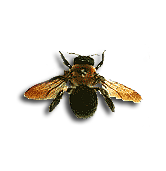General Characteristics:
- ¾ -1 inch in length
- Coloration is metallic blue/black with green or purplish reflection
- Covered with orange or bright yellow hairs
- Top of the abdomen is black and possesses little to no hair
- Females have a dense brush of hairs on their hind legs
- Bores distinct holes in dry woods for nesting
- Although females are capable of stinging, they rarely do and males may act aggressively towards humans encroaching active nests but cannot sting
Reproduction:
- Primarily nests in dry structural softwoods (conifers) but will occasionally nest in some hardwoods
- Tends to nest in same area for multiple generations
- Nesting galleries are about 15cm in diameter and can extend up to 45cm deep in new galleries
- Direction of galleries is dependent upon grain of wood with this species choosing to follow the grain direction
- Usually constructs one nest per year
- Mating occurs in the Spring and young are born in the early summer
- Adult bees emerge in late summer and over-winter as adults in the same burrows
- There are usually 6-8 eggs laid in an active gallery per year
Signs of Infestation:
- Many types of woods are used for nesting but dry softwoods are preferred
- Unpainted or weathered woods are more susceptible to tunnelling
- Common nesting sites include siding, eaves, railings, window sills, doors or any other accessible wooden structures
- Yellowish or brownish fecal stains may be present below the gallery entrances
- The major concern with this species is the reduction of wooden structural integrity
- A buzzing or drilling sound is heard when the bee is actively boring
- If holes are not visible, sawdust on the ground may reveal locations
Control Techniques:
- Painting or varnishing wooden structures will hinder the nesting of this species
- Insecticides such as dusts, wettable powders, microencapsulated products, or aerosols may be used ACCORDING TO LABEL SPECIFICATIONS AND IN ACCORDANCE WITH FEDERAL, PROVINCIAL AND MUNICIPAL LAWS
- After insecticide treatment, allow bee to be exposed to chemical and then plug hole with plastic putty, wood filler or other similar substances
Please click here to contact a Focus Pest Control professional to inquire about further treatments for this pest species.
References:
Benett, Gary W., et.al.. Truman’s Scientific Guide to Pest Control Operations. Duluth: Advanstar Communications, 1988. p. 203-204.
“Center for Urban and Structural Entomology – Carpenter Bees” (On-line). Texas A&M University. Accessed Dec.1, 2009 at http://urbanentomology.tamu.edu/wdi/carpenter_bee.cfm.
“Large Carpenter Bees” (On-line). University Of Florida Institute of Food and Agricultural Sciences – Department of Entomology and Nematology. Accessed on Dec. 1, 2009 at http://entnemdept.ifas.ufl.edu/creatures/misc/bees/xylocopa.htm.
Disclaimer:
The Focus Pest Control ‘Pest Library’ is an educational resource written largely to educate the general public about common pests in Ontario. The Focus ‘Pest Library’ does not include all species in Ontario, nor does it include the most recent scientific data about species we describe. Though we edit our accounts for accuracy, we cannot guarantee all information in those accounts. While Focus Pest Control staff and contributors provide references to books and websites that we believe are reputable, we cannot necessarily endorse the contents of references beyond our control.
(Back to top)
|


